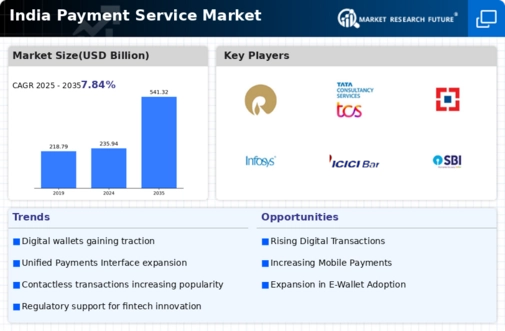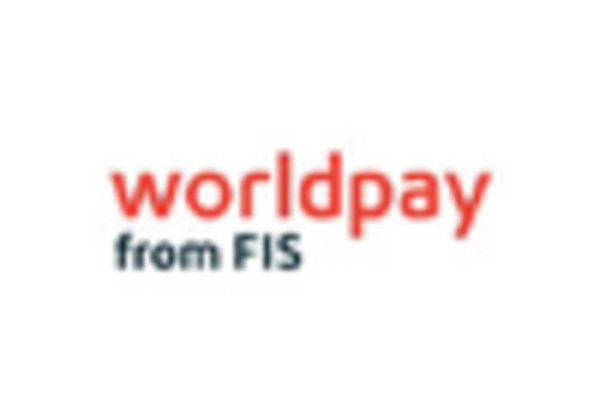Rising E-commerce Adoption
The rapid growth of e-commerce in India significantly influences the payment service market. With online retail sales projected to reach $200 billion by 2026, the demand for efficient payment solutions is escalating. Consumers increasingly prefer digital payment methods for online purchases, driven by the convenience and security they offer. Payment gateways and digital wallets are becoming essential for e-commerce platforms, facilitating smooth transactions. As more businesses transition to online models, the payment service market is likely to expand, with a projected CAGR of 20% over the next five years. This trend underscores the importance of integrating diverse payment options to cater to a growing base of online shoppers.
Adoption of Fintech Innovations
The emergence of fintech companies is reshaping the payment service market landscape in India. These firms leverage technology to offer innovative solutions, such as peer-to-peer lending, blockchain-based transactions, and advanced fraud detection systems. As of November 2025, the fintech sector is estimated to be valued at $150 billion, with a significant portion dedicated to payment services. The agility and customer-centric approach of fintech companies attract a diverse clientele, from small businesses to large enterprises. This competition fosters innovation and drives traditional banks to enhance their digital offerings, thereby expanding the overall payment service market. The collaboration between fintech and traditional financial institutions is likely to create a more robust ecosystem.
Increasing Smartphone Penetration
The proliferation of smartphones in India is a pivotal driver for the payment service market. As of 2025, smartphone penetration in India is estimated to exceed 80%, facilitating access to digital payment platforms. This trend is particularly pronounced among younger demographics, who are more inclined to adopt mobile payment solutions. The convenience of using smartphones for transactions, coupled with the availability of various payment apps, enhances user engagement. Furthermore, the Indian government's push for a digital economy, including initiatives like Digital India, supports this growth. As more consumers embrace mobile technology, the payment service market is likely to experience substantial growth, with mobile transactions projected to account for over 50% of total payment transactions by 2026.
Growing Consumer Awareness and Trust
Consumer awareness regarding digital payments is steadily increasing, contributing to the growth of the payment service market. Educational campaigns by both the government and private entities have played a vital role in demystifying digital transactions. As of November 2025, surveys indicate that over 70% of consumers feel confident using digital payment methods. This growing trust is essential for the market's expansion, as it encourages hesitant users to adopt digital solutions. Additionally, the rise in cybersecurity measures and fraud protection has further bolstered consumer confidence. As awareness continues to grow, the payment service market is expected to witness an influx of new users, thereby enhancing transaction volumes and overall market dynamics.
Government Initiatives and Regulations
Government policies play a crucial role in shaping the payment service market. Initiatives such as the Pradhan Mantri Jan Dhan Yojana aim to increase financial inclusion, thereby expanding the user base for digital payments. Regulatory frameworks established by the Reserve Bank of India (RBI) promote secure and efficient payment systems. The introduction of the Unified Payments Interface (UPI) has revolutionized peer-to-peer transactions, making them seamless and instantaneous. As of November 2025, UPI transactions have surged, with over 10 billion transactions recorded in a single month. Such government-backed initiatives not only enhance consumer trust but also stimulate competition among service providers, ultimately benefiting the payment service market.

















Leave a Comment